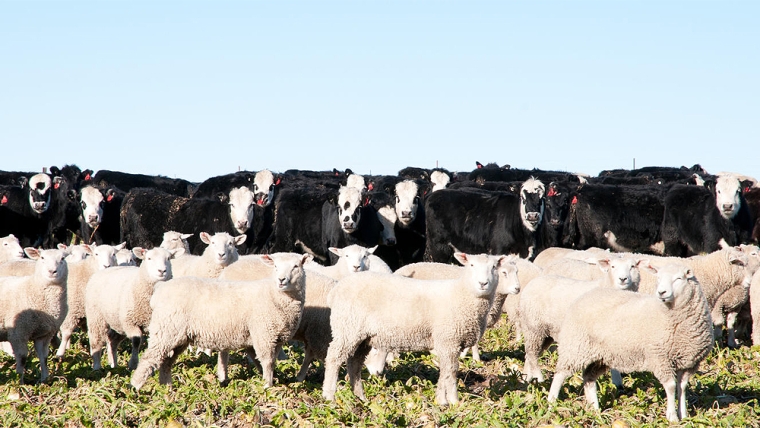
This article started in my mind as an article on New Zealand’s sheep and beef farms. But once I started, I was quickly self-reminded that there are fundamental differences between the islands.
In the North Island, what were traditionally thought of as sheep farms, are now earning more from beef than sheep. In contrast, in the South Island sheep still reign supreme on non-dairy pastoral land.
So, this article focuses on the North Island, with the South Island left for another time.
Industry-good organisation Beef+Lamb has three categories of sheep and beef farms in the North Island. These are labelled Class 3, 4 and 5 in ascending order of farm intensity. As for where Classes 1 and 2 have got to, they are the least intensive South Island pastoral farming systems. Likewise, Classes 6,7 and 8 are the most intensive systems, also all in the South Island.
The analysis that follows draws on data from the Beef+Lamb Survey of sheep and beef farms through to and including 2024/25 data, plus early estimates for 2025/26 as at 11 September 2025.
Class 3
The Class 3 sheep and beef farms are on hard hill country, typically in the back country. There are an estimated 920 farms in the category, averaging 839 hectares and an average stocking rate of 7.8 stock units per hectare. Cattle stock units have crept up over the last ten years to now (2025) average 47% of total pastoral stock units.
For the last two years, the cattle stock units, which are mainly traditional beef-cow systems, have been earning a higher gross income than sheep stock-units despite the high prices for sheep meat. On a farm basis, more than half of total income now comes from cattle.
Expense items, except for wool, are not separated out by species. So, it is not possible to calculate the separate profitability of sheep and cattle from the survey. But it is a fair bet that sheep require most of the animal health and labour, which reinforces that cattle net of costs will have indeed been more profitable than sheep.
As for wool, shearing expenses have exceeded gross wool income for the last six years. It is hard to think of the strong wool produced on these farms as being anything more than a weed.
Overall profits on these big farms have remained positive but return on capital has averaged only 0.6 percent over the last 5 years and 1.9 percent over the preceding five years. The 2024/25 return on assets has been provisionally calculated at only 1.2 percent despite the high meat prices.
Also, what needs to be factored in is that family living expenses tend to be high on these back-country farms with little option on many farms to boarding school for secondary education.
The only possibility to earn more on these back-country farms is to further increase cattle relative to sheep, or perhaps forestry. However, the professional forestry companies have shown minimal interest since Cyclone Gabrielle. The land is typically too remote from ports, and the harvest plus clean-up costs, including associated risks, have become too great for production forestry to stack up on this typically steep land.
This leaves so-called ‘permanent’ carbon forestry, with a focus on the areas of a farm that are least productive. The economics of carbon still stack up, and now, with some cash in hand, would be a good time to start. However, many and perhaps most farmers are not enamoured with carbon forestry, with a market that is seen as artificial, and created by regulations.
Beef+Lamb estimates the land and buildings excluding homestead as being worth $11,900 per hectare in 2024/25, down from $13,100 in 2021/22 at the height of the forestry boom. However, I am sceptical about the latest values, because there have been vey few sales. Banks are not interested in any significant lending to these farms.
Class 4
The Class 4 farms are the classic North Island hill farms and there are an estimated 3055 of these farms. This is the biggest number of farms in any of the eight New Zealand sheep and beef farm classes. This farm-type comprises over 60 percent of North Island sheep and beef farms, and around one third of all New Zealand sheep and beef farms of potential economic scale.
The Class 4 farms average 486 hectares and carry on average 8.9 stock units per hectare. Fifty percent of stock units are beef. As with the Class 3 farms, shearing costs have exceeded wool income for the last six years.
Comparing gross income from meat and livestock sales from each species, the gross returns from beef have beaten sheep by more than 20 percent for the last two years and this also applies to projections for the current year. If data were available for animal health and labour costs on a species basis, then the difference in net earnings difference between the two species would be even greater. Beef returns on this class of land are also helped by dairy beef which has no maternal overheads.
Net returns per hectare are higher on the Class 4 farms than the harder Class 3 type of land, but percentage returns on capital are equally dismal, averaging only 0.7 percent over the last five years. This is greatly influenced by land and buildings excluding the homestead being currently valued at $15,030, down from $17,250 in 2021/22. As with Class 3 land, I am sceptical of recent values because not many of the Class 4 farms have been selling.
One key difference between Class 4 and Class 3 farms is that more of the Class 4 farms are well within 100 km range of port facilities which is relevant to production forestry. Also, much of the land is sufficiently easy contour to be viable for production forestry which can be combined with carbon earnings for the first 16 years. Farmers can now plant 25 percent of the farm to forestry as a matter of right without special consents for change of land-use. That has to be of interest when farmers are charting a path to the future.
Class 5
Class 5 farms are finishing farms. There are 1045 of these farms and they average 328 hectares. They comprise 20 percent of North Island sheep and beef farms but comprise only 13 percent of the North Island sheep and beef farm area. Consistent with their finishing-class status, they carry less breeding stock than other sheep and beef farms. Dairy beef is important.
Cattle comprised 61 percent of stock units in 2024/25. Total farm income from cattle has exceeded sheep income for all of the last ten years, and was more than double the income from sheep in 2024/25. Shearing expenses have exceeded wool income for the last seven years.
The return on total farm capital was 0.8 percent in 2024/25. This dismal return despite high meat prices was in the context of total farm capital of $25,700 per hectare, down from $31,500 in 2021/22.
The Big Picture
It is clear when taking an overall North Island perspective, that beef animals are now more important than sheep as a source of income on so-called sheep and beef farms. Wool has been a negative for at least six years. The big question is whether farmers will further respond to these price signals. If there is a further shift to beef, then it will be dairy beef that increases. I emphasise that this is a North Island story; there are good reasons why the South Island is different.
*Keith Woodford was Professor of Farm Management and Agribusiness at Lincoln University for 15 years through to 2015. He is now Principal Consultant at AgriFood Systems Ltd. You can contact him directly here.
1 Comments
In the South Island Alliance & Silver Fern Farms are struggling. Both have recapitalised by selling 50% or more to overseas interests. Of the two, SFF are though doing the better. This may be attributed to the acrimonious but necessary takeover of the Richmond’s operation in the NI which gained them a very large percentage of NZ’s beef production. The rise and rise of dairying during that time assisted with providing manufacturing beef, an economic product with a sure market.

We welcome your comments below. If you are not already registered, please register to comment.
Remember we welcome robust, respectful and insightful debate. We don't welcome abusive or defamatory comments and will de-register those repeatedly making such comments. Our current comment policy is here.